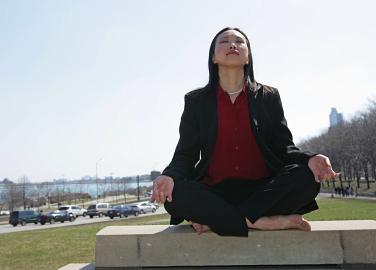| The Yoga of Now
There was a lot to absorb on September 11, 2008, with Hurricane Ike barreling across the Gulf of Mexico toward Texas as 9/11 memorials were underway across the United States. At times such as these, when Mother Nature mysteriously magnifies human events, it is possible to see with the eye of the soul—to try “read the book of life” with detachment and discern what it is saying. But it’s also easy to get swept up in the swirling tide of events. Change is occurring at a galloping pace, causing familiar landmarks to disappear. The reality that once seemed solid and immovable is shifting, leaving us feeling increasingly unanchored and disoriented in the outer world.
 |
Our times seem to require a new kind of compass—an inner compass of the soul to steer our course through shifting tides and currents. Generating this inner compass is the goal of the “yoga of now,” a homegrown brand of yoga born of necessity in this extraordinary time. Many of us know in the depths of our being that we are approaching a higher dimension of reality, yet that inner sensing is rarely, if ever, reflected in the outer reality that shapes our lives in the world. The purpose of this self-created yoga is to remind ourselves why we are here and where we are headed, and to help us through the pain of being alive when “the earth groaneth” with the travails of humans and other living beings.
First, the pain. There is a technique for overcoming pain that is based on breathing. Healers who work with people in pain often advise their clients to “breathe through it.” The idea is to unclench the surrounding muscles and nerves and to relax by breathing deeply and, on the in-breath, to visualize healing energy entering the body and flowing into the painful area. A similar technique can be used in “the yoga of now:” breathe deeply, and, on the in-breath, when the body is relaxed, call to mind our soul’s purpose for being on Earth at this moment.
Four years ago, during another stressful period for the United States and the world, many people received a message that began, “My friends, do not lose heart. We were made for these times.” Those words were the prelude to a letter that circumnavigated the globe many times via the Internet. It was written by Clarissa Pinkola Estes, best-selling author, poet, and psychoanalyst. Addressing all awakening souls the letter said, “For years, we have been learning, practicing, been in training for and just waiting to meet on this exact plain of engagement.” It went on:
| |
I grew up on the Great Lakes and recognize a seaworthy vessel when I see one. Regarding awakened souls, there have never been more able vessels in the waters than there are right now across the world… Look out over the prow; there are millions of boats of righteous souls on the waters with you… |
|
The author exhorted her readers not to “faint over how much is wrong or unmended in the world” but to focus one's thoughts on the fact that “We are needed, that is all we can know.”
| |
Ours is not the task of fixing the entire world all at once, but of stretching out to mend the part of the world that is within our reach. Any small, calm thing that one soul can do to help another soul, to assist some portion of this poor suffering world, will help immensely. It is not given to us to know which acts or by whom, will cause the critical mass to tip toward an enduring good. |
|
Addressing the potential of each soul, the author intoned:
| |
One of the most calming and powerful actions you can do to intervene in a stormy world is to stand up and show your soul. Soul on deck shines like gold in dark times. The light of the soul throws sparks, can send up flares, builds signal fires, causes proper matters to catch fire. To display the lantern of soul in shadowy times like these—to be fierce and to show mercy toward others, both are acts of immense bravery and greatest necessity. Struggling souls catch light from other souls who are fully lit and willing to show it. |
|
Urging her readers to resist discouragement, Pikola Estes affirmed: “In my uttermost bones I know something, as do you. It is that there can be no despair when you remember why you came to Earth…” Her words ring as true today as when she penned them, perhaps even more so. They resound like a clarion call to the soul—to the part of us that has begun to remember, however dimly or clearly, that we are here on Earth right now for a reason. The reason may be better known to the Soul on its own plane than to our ordinary awareness. But somewhere in our depths, in our “uttermost bones,” we know that being alive at this time is no accident.
The goal of “the yoga of now” is simply to remember—to remind ourselves that we are here for a purpose, and to strive to bring into conscious awareness the individual purpose that each soul has chosen to serve here and now, in this unfolding process of planetary death and rebirth. As with any form of yoga, this one involves self-disciplines. They are few, and they are not excessively demanding, but they require regular practice to reach the goal as do more traditional forms of yoga.
All forms of yoga have the same basic goal. In the Online Etymology Dictionary, the Sanskrit meaning of the word is "union, yoking (with the Supreme Spirit)." Another dictionary defines yoga as: "a school of Hindu philosophy advocating and prescribing a course of physical and mental disciplines for attaining liberation from the material world and union of the self with the Supreme Being or ultimate principle." Yet another: "a Hindu discipline aimed at training the consciousness for a state of perfect spiritual insight and tranquility."
Still another form of traditional yoga, "raja" yoga or the yoga of the mind, portrays the goal of union somewhat differently. Raja means royal, conveying the idea that the mind is the royal path to attaining conscious union—first with the light of the soul and then with the monadic spark of divine will and purpose. This form of yoga lies at the heart of the modern esoteric teachings known as the Ageless Wisdom. Those who seek training in raja yoga are searching for spiritual insight and tranquility, though not in order to leave this material world, as "liberation" is generally understood. The idea is to become liberated from material attachments in order to fulfill the soul's purpose for being on Earth.
In creating this simple "yoga of now," we are borrowing heavily from raja yoga. The mind is the principal instrument for shifting one's identity from that of a material being to that of a spiritual being—a Soul presently incarnate in physical form. It is the mind that allows us to remember, to remind ourselves regularly, that we are here for a reason. And it is the mind, under the direction of the soul, that enables us to shut down the clatter of the outer world, with its fearsome factual realities, and to quiet the emotions, enabling us to hear the inner voice—the voice of the soul—which knows the purpose that each of us was born to fulfill in these times.
The first part of our homespun yoga can be done with the aid of any mechanism that will serve as a reminder—from an electronic device to the old-fashioned rubber band on the wrist. The reminder serves as a trigger to remove one's focus from the external world and reconnect with one's true identity. Once that shift in focus occurs and the sense of inner union is established, we recommend the following steps. First, say to yourself, on taking a deep breath and holding it, "I was born for these times," allowing that reality to sink deeply into your awareness. Then on the out-breath say to yourself, "We were made for these times," while linking with the countless souls throughout the world who are awakening and searching for their place in the plan of evolution. We recomming this exercise with growing frequency throughout the day, while consciously infusing both thought-forms with vital energy.

The second part of this “yoga of now” involves meditation to discover—or learn more about—the specific purpose that one's soul is here to serve in this transitional period. The essential goal of many forms of meditation is to quiet the mind and free it from the constant chatter with which it is normally flooded, enabling the light of the soul to filter into one’s conscious awareness. Some people meditate best in a traditional, seated posture; others find that activities like gardening serve the purpose. One can also meditate or contemplate (another means of focusing the mind) while engaging in an activity like journal-writing or reading with 'the eye of the soul.' By stilling the lower mind it becomes possible to build a bridge in consciousness to the soul, which holds in safekeeping the purpose of our present incarnation until we are ready to fulfill it. Like any discipline, this one requires repetition and commitment to sustaining it over time.
To visualize the potential benefit of this homegrown "yoga of now," it can be useful to think of ourselves as cells in the body of our planetary life—an image that is both metaphor and reality. The body of our planet is currently ailing, even as the portion of its consciousness embodied by awakening humanity is beginning to grow and evolve into a light-bearing force. The more integrated and soul-infused each one of us becomes, the more we live in harmony with the consciousness of the greater being called Earth, supplying healing energy to other cells. To become healthy in these times, however, we have to avoid feeling faint or discouraged, as Clarissa Pinkola Estes implored us to do. We have to remember who we are, in truth, and to own the reality that we were “made for these times.”
Nancy Seifer and Martin Vieweg
September 2008
See also:
Living as a Soul
The Greatest Secret
Eye of the Soul
Latest Postings
|